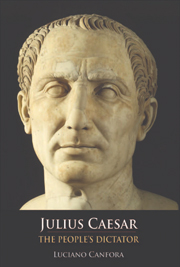Book contents
- Frontmatter
- Contents
- Translators' Note
- Acknowledgements
- Foreword
- PART I FROM SULLA TO CATILINE
- PART II FROM THE TRIUMVIRATE TO THE CONQUEST OF GAUL
- PART III THE LONG CIVIL WAR
- PART IV FROM THE CONSPIRACY TO THE TRIUMPH OF CAESARISM
- 29 Inklings of Conspiracy
- 30 ‘Iure caesus’
- 31 The Lupercalia Drama
- 32 The Dictatorship
- 33 Epicureans in Revolt?
- 34 The Hetairia of Cassius and the Recruitment of Brutus
- 35 A Conspirator's Realism: Cassius Settles for the Second Rank
- 36 Some Unexpected Refusals
- 37 Cicero – an Organiser of the Conspiracy?
- 38 The Serious Mistake of Dismissing the Escort
- 39 The Dynamics of the ‘Tyrannicide’
- 40 ‘Where's Antony?’
- 41 Caesar's Body: How to Turn Victory into Defeat
- 42 The Wind
- Chronology
- Bibliography
- Index
41 - Caesar's Body: How to Turn Victory into Defeat
from PART IV - FROM THE CONSPIRACY TO THE TRIUMPH OF CAESARISM
Published online by Cambridge University Press: 05 August 2013
- Frontmatter
- Contents
- Translators' Note
- Acknowledgements
- Foreword
- PART I FROM SULLA TO CATILINE
- PART II FROM THE TRIUMVIRATE TO THE CONQUEST OF GAUL
- PART III THE LONG CIVIL WAR
- PART IV FROM THE CONSPIRACY TO THE TRIUMPH OF CAESARISM
- 29 Inklings of Conspiracy
- 30 ‘Iure caesus’
- 31 The Lupercalia Drama
- 32 The Dictatorship
- 33 Epicureans in Revolt?
- 34 The Hetairia of Cassius and the Recruitment of Brutus
- 35 A Conspirator's Realism: Cassius Settles for the Second Rank
- 36 Some Unexpected Refusals
- 37 Cicero – an Organiser of the Conspiracy?
- 38 The Serious Mistake of Dismissing the Escort
- 39 The Dynamics of the ‘Tyrannicide’
- 40 ‘Where's Antony?’
- 41 Caesar's Body: How to Turn Victory into Defeat
- 42 The Wind
- Chronology
- Bibliography
- Index
Summary
In the moment in which the conspirators leave the body of the dictator unattended and abandon the idea of getting rid of it by throwing it into the Tiber, they lose everything. The Caesarians begin to regain ground when they are able to make political and emotional capital out of the corpse, whose cumbrous presence weighs increasingly heavily, and in the end decisively, on Roman politics. Shakespeare recognised the ‘potential’ of this corpse when in Antony's (partly imagined) speech before the bloodstained body he captured the mood of the urban plebs.
In the very first moments after the murder, Brutus and the others make every possible effort to get the situation under control. Their efforts are mostly doomed to failure. The fact that for a brief moment they seemed to have succeeded is demonstrated by Antony's panic: he dresses as a plebeian and flees. Brutus tries to talk to the senators, but they are bent on fleeing with all speed from the scene of the attack they have witnessed. Neglecting to dispose of the body and proceeding to a renunciation of all Caesar's works, they can think of nothing better than to go to the Capitol, waving their daggers and calling on imaginary citizens – the streets are deserted and the shops shut – to ‘make the most of their freedom’. At the Capitol they wait a short while. Eventually some senators appear, and a small crowd, urging the conspirators to leave the Capitol.
- Type
- Chapter
- Information
- Julius CaesarThe People's Dictator, pp. 337 - 343Publisher: Edinburgh University PressPrint publication year: 2007



